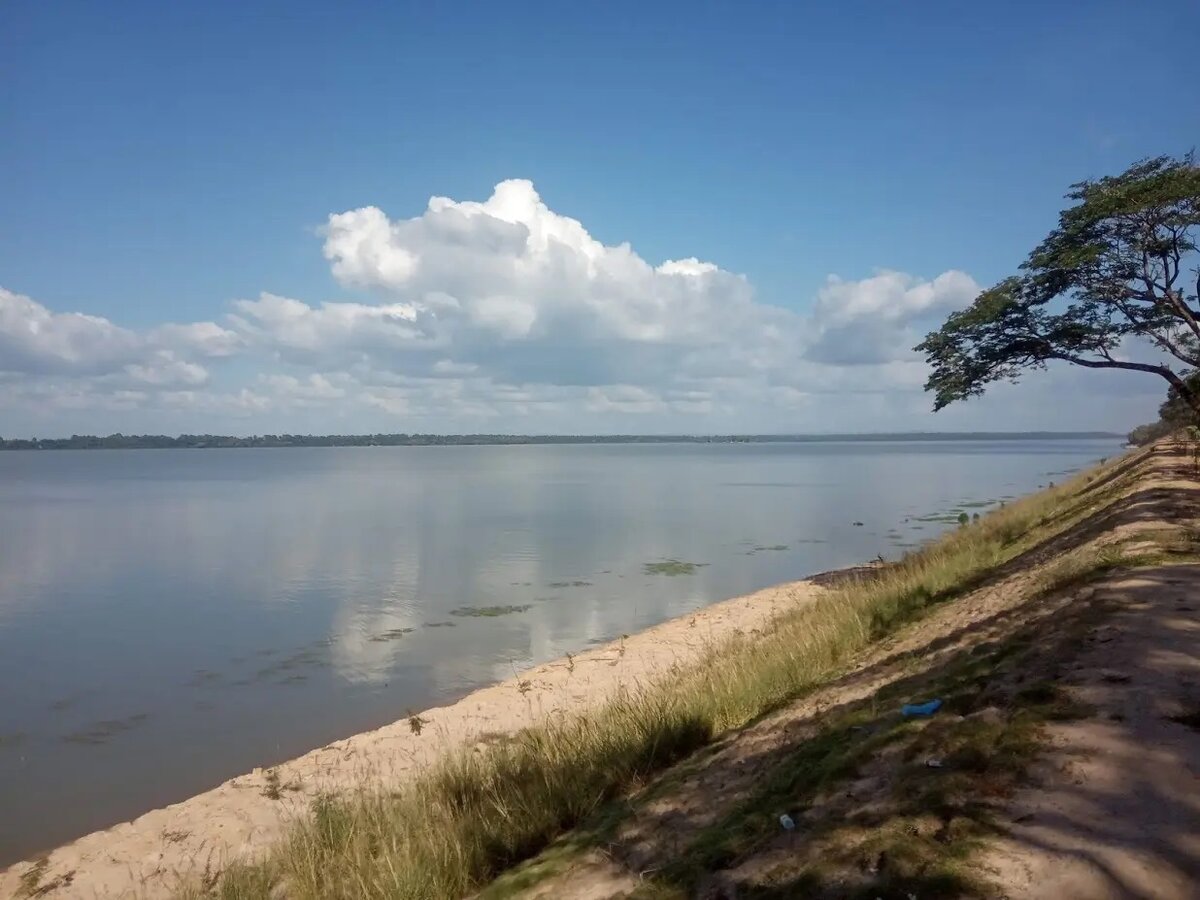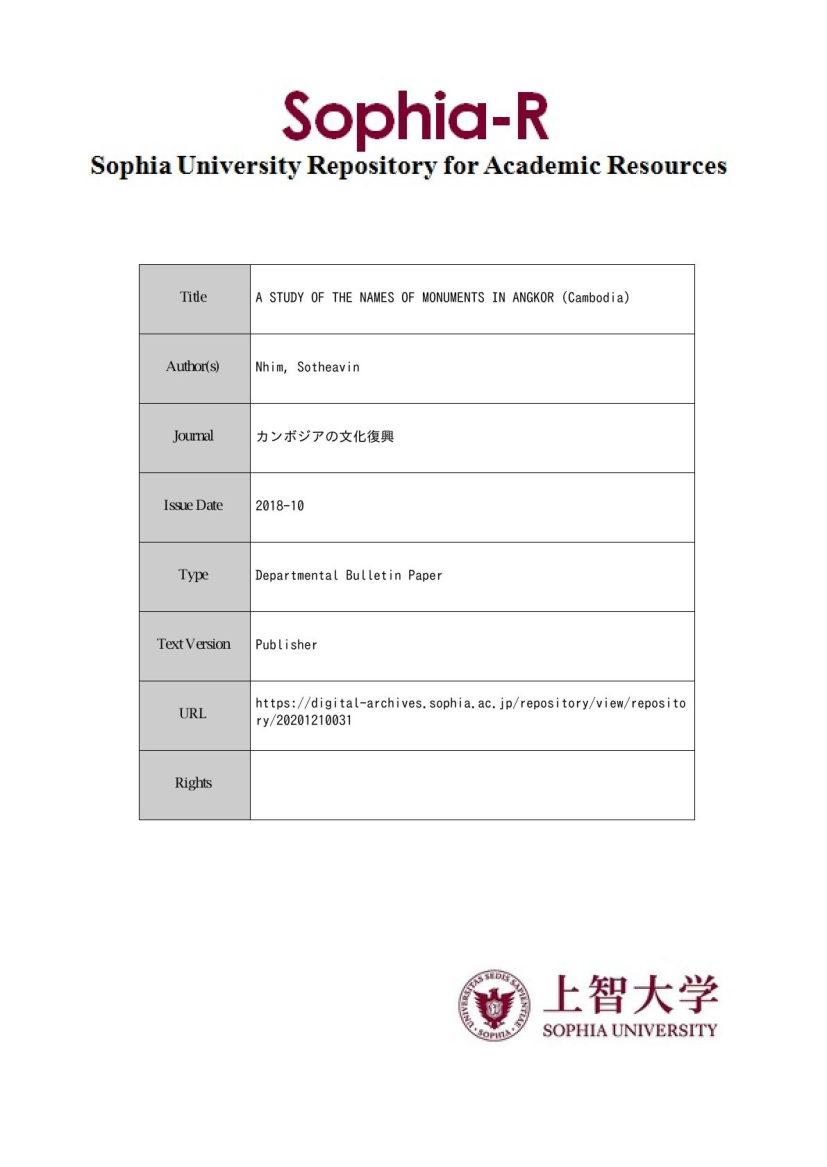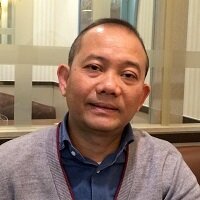Drawing from previous epigraphic and anthropological research — in particular Étienne Aymonier’s findings, Lunet de Lajonquiere’s recension of monuments, Saveros Pou’s contribution to epigraphic studies and toponymy, or Ang Choulean’s essay “In the Beginning was the Bayon” (in Joyce Clark, ed., Bayon: New Perspectives, River Books, Bangkok, 2007), but also from present-day oral traditions in the temples’ area that go back to legends dating back from the Middle Period, the author offers here probably the most exhaustive attempt in etymology and symbolism of Angkor’s monument names.
The names of the five gates of Angkor Thom were either labeled or referred to by
foreign researchers as South Gate, North Gate, West Gate, and East Gate, and also the Barays were
labeled as East Baray, West Baray, North Baray, and so on. This manner of naming is a phenomenon
that has arisen in modern times due to the European researchers, since in the case of mapping, we
observe that there is only “length and width” with no depth, and hence the upper end of the map
would naturally indicate the north.
In general however all of such names were affixed by the local inhabitants, as for example with regard to the Gates of Angkor Thom, the South Gate is called the “Thvear Tonle Om = Tonle Om Gate,” which literal translates as “Gate of rowing (a boat on a) river,” the North Gate is called “Thvear Dei Chhnang = Dei Chhnang Gate,” meaning “Gate of clay (that can produce) pottery,” the West Gate is “Thvear Ta Kav = Ta Kav Gate), and the East Gate is called “Thvear Khmoch = Gate of the Death.” As for the Barays, the East Baray is referred to by the villagers as “Thnal Baray,” which means “Road of Baray,” and the West Baray is called “Baray Toek Thla = reservoir with purified or clear water.”
Baray
In Khmer thinking, the name Baray is remembered from the accounts of the ancestors through
a famous legend, which probably appeared in the middle period of Cambodia. According to the
legend, the Barays are called ‘Baray Pros, or Baray of the male’ and ‘Baray Srei, or Baray of the
female.’ Baray Pros signifies the Thnal Baray which has no water, in contrast to Baray Srei which
still contains lots of water, that is the Baray Toek Thla.
There are the same stories of the female always being ahead in Khmer society at that time. The
story of ‘Phnom Pros’ (the mountain of the male) and ‘Phnom Srei,’ (the mountain of the female),
is found in the Kompong Cham province. Geographically, Phnom Srei is higher than Phnom Pros.
Another story presents the same idea, namely that the large pond belongs to Srah Srei (pond of the
female), and the small pond is referred to Srah Pros (pond of the male). These two ponds are located
within the royal palace of Angkor Thom, close to the Phimeanakas temple.
This idea probably refers to the Austro-Asiatic society conception, that the female or ‘Me’
means ‘mother, or leader’.
The legend of Baray Pros and Baray Srei is as follows:
[A long time ago, according to the Srok Khmer (Cambodia) custom, the women had to ask the
men for marriage. This tradition was criticized by those women who did not have sufficient beauty
to engage the men. For this reason, all the women challenged the men to a game, where if one of the
groups could dig a Baray deeper than the other, it meant that the successful group was the ‘winner.’
The losers had to promise that they would ask the winning group to marry them. Before playing the
game they made a condition, namely, “we must dig only one night until the morning star rises, and
then we stop.” While they were playing the game, the women cleverly created a paper lantern flying
in the sky, and immediately the men saw this and thought the morning star had arisen. They stopped
their digging and slept. In the morning, the men knew that they had lost the game, and so the men
had to ask the women to marry them. Since that time, the men had to ask the women for marriage,
and after marriage the man moved in to live in the woman’s house, a custom that survives until the
present day.]
Through this legend the name of the Baray probably came to be used by the local inhabitants
since the middle period of Cambodia, when the legend appeared in Khmer society. Therefore the
word Baray designated a reservoir that is surrounded by an embankment, and it was man-made,
in order to preserve water for daily use. It was also representative of the religious purpose and
prosperity of the state.
The name was also mentioned both in the inscriptions and in the historical legend of Lpoek
Nagarvatt, “the foundation of Angkor Wat.” It has been found as the Sanskrit ‘Vaijayanta,’ in the
Khmer ‘Vejayantaratna or Devavajayanta,’ and in the Pāli ‘Vejayanta’ or ‘Bejayant.’68 The name
appeared in the poem of Lpoek Nagarvatt in the 17th century.69
Here is a portion of the poem from the original Khmer text of E. Aymonier, published in 1878:
“Kit kan oy yak Bejayant noh mak
sāń oy putrā yań yal thom khbas
ban yoj soh sā as tamń devaţā
sňap sňaeń dīdai”.70
In the poem, it is stated that Indra ordered Braḥ Bisṇukar to create a replica of the palace of
Bejayant on earth, as a souvenir for his son Ketumālā. This was because his son (Ketumālā) was a
half human-god, for which reason he could not live in Heaven. Hence, the name of the Indra palace
in the legend from the 17th century presents the idea of the Khmer people, that the name was a
deformation of Bejayant > Bayon.71 It is the same with the name Indrapath or Indrapraṣṭh.
In addition, the inhabitants of Angkor sometimes call this temple “Prohm Bayon.” Prohm being
the Khmer pronunciation of the name of the god Brahma. Prof. Ang Choulean remarked, “the Bayon
and its projection on the five gates of Angkor Thom convincingly show images of Prohm,” and he
added, “traditionally we do not say ‘Prohm Bayon’ to describe the faces on both the central temple
and the gates of the old city?”
There is no doubt that the term “Banteay” indicates enclosure, and “Samre” is the name of
one of the ethnic groups in Cambodia. The Samre people still live in Phnom Kravanh (Cardamom
Mountains), and in the Angkor area in Kvau village. According to the Cambodian dictionary, the
term “Samre” signifies a black line (Chnūt Khmau), for example we have: me samre, sambur samre
(black skin). The term is also shown in relation to the word sre (rice field), as for example anak sre,
“the people who cultivated rice.”
Zhou Daguan, in his report, wrote as follows about the ethnic groups:
“The wild men from the hills can be brought to serve as slaves. Families of the wealthy may
own more than one hundred slaves, those of lesser means content themselves with ten or twenty,
and only the very poor have none. These savages are captured in the wild mountainous regions,
and are of a wholly separate race called Chouang (brigands). After being brought to town, they
dare not venture out of their owners’ houses. In the course of a dispute, they called their adversaries
‘Chouang,’ they hate them to the marrow of their bones, and looked down on them as wretches.”96
The report has also mentioned all the activities of the ethnic group who played an important
role in Angkor. Otherwise, the ethnic Samre have been thought to have functioned in the Angkor
period as servants, or to do other jobs. This ethnic group are now found in Khmer society, which
serves as a good evidence to reflect upon the understanding of the Khmer civilization of the Angkor
time.
As R. Baradat noted, in 1909 when King Sisowath visited the villages around Angkor, he
made a speech that also mentioned the names of the ethnic groups, who remained in some of the
ancient villages around Phnom Kulen (Srah Daun Rik of the Kvau Village). Baradat also quoted
from the work of J. Moura, who stated that, “the Samre are the original habitants who still existed as
a grand majority in the Angkor province, and who provide real evidence of the Khmer civilization
of the past, but they have not yet attained considerable urban development, and their villages are not
composed of more than about a dozen small huts or more.”
According to the local inhabitants, the name of the “Banteay Samre,” is thought to be related
to an ethnic man named Ta Trasak Pha-em (Sweet Cucumber Ancestor), an ethnic Samre who
occupied the throne after the king was killed by his spear. After he became king, most people,
ministers and officers were not happy with him, because he did not belong to the royal family and
was just an ethnic person. When he realized that it was impossible to be a king in Angkor city, he
decided to leave the city and came to hide in a sacred place.
His hiding place at that time is believed to have been at the Banteay Samre temple that is
located outside the royal palace, and he built a high enclosure surrounding the temple in order to
protect himself. For this reason, the local inhabitants used the word “Banteay Samre”, to signify the
enclosure surrounding the temple “Banteay”, where the king Samre and his family lived (Ph. 9&10).
The legend of Ta Trasak Pha-em was also mentioned in the Cambodian Royal Chronicle
(Chronicle of Vāṃṅ Juon).99 According to the chronicle, Ta Trasak Pa-em was the father of king
Nibbānapad, who reigned from the year 1346 to 1351; and Ta Trasak Pa-em was a usurper of the
Angkorian throne. The legend is not only known in Cambodia, but it is also mentioned in the
Burmese chronicles. In the Burmese chronicle it is stated that a farmer became a king after he killed
a king named “Thy” when the latter ate his cucumber. His name is Nyaung‑u Sawrahan, who reigned
from 931 – 964 AD.100 However, it is said that the history itself is very antiquated, and was most likely
subjected to historical exaggeration. The creator of this legend most likely fabricated the report
during the time when Angkor became powerless, or during a strain in Angkorian supremacy.
Although the legend appears as untrue or exaggerated, and not so glorious when viewed from
the standpoint of western people, yet it reveals a popular understanding of the oral tradition that
is difficult to grasp, and it is used in Khmer society as evidence related to its religion and culture.
Despite its simplicity the temple certainly belonged to the 12th century, and it is of the Angkor Wat
style, which is dedicated to Brahmanism.



